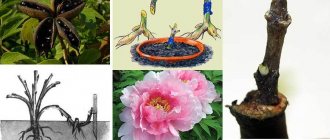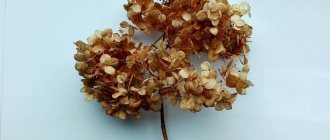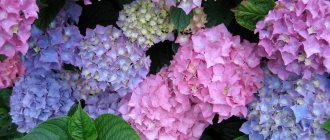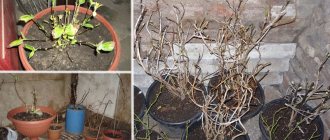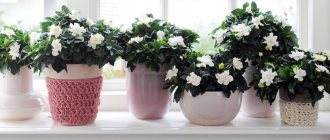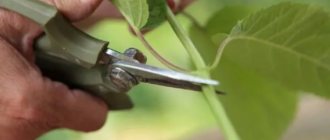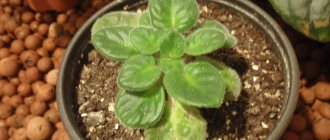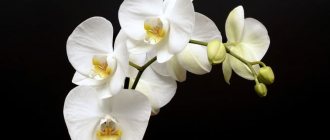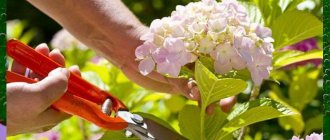Plants » Flowers
0
355
Article rating
Larisa Kosterina
Silver dollar hydrangea is another gem among the paniculate species created in the new millennium. Yes, it lacked the aggressive marketing campaign of the Limelight hydrangea, but its beauty and unique properties mean that this variety is on the same level of winners.
Hydrangea silver dollar photo
Description of the variety
Full name: Hydrangea paniculata Silver Dollar.
The variety, grown by Dutch breeder Pieter Zwijnenburg at the turn of the century, received the AGM (Award of Garden Merit) from the British Royal Horticultural Society in 2008 for its outstanding ornamental qualities, stability of shape and resistance to disease.
The flower received the highest score, three points, for its popularity among European gardeners.
External parameters
Hydrangea Silver Dollar produces large (up to 25 cm) conical panicles, consisting mainly of sterile flowers (those with larger petals).
Light green flowers appear in mid-July, later changing to almost pure white, becoming pale pink in late summer and early fall.
The panicles hold well on strong raspberry-brown stems in both wind and rain. The leaves are ovoid or oval in shape, pointed, dark green, and do not change color in the fall.
The shrub is compact, moderately growing, grows quickly, and does not lie down under the weight of massive inflorescences.
Bush dimensions:
- height – up to 1.8 m;
- diameter – up to 1.5 m.
The correct natural shape, dense panicles, completely covered with large sterile flowers, long flowering - all this transforms the Silver Dollar from an ordinary resident of a flower garden into its main decoration.
The flowers stand well when cut and retain their shape and color for a long time when dried.
Landing Features
Paniculate hydrangeas are found in the wild in the south of Sakhalin, China and Japan. This is the most frost-resistant species of the hydrangea family. The plant forms panicles on the current year's shoots, so even frosts down to -34° C do not damage the flower buds.
Hydrangea dollar silver
Unpretentious, growing in any acidic soil, undemanding to lighting, pan-hydrangea can only suffer from improper agricultural practices during cultivation.
Deadlines
Planting material is usually sold with a closed root system, so planting can be carried out throughout the entire period with an average daily temperature above zero.
In central Russia this is the first half of May. At this time, the snow has already melted, the soil is suitable for cultivation, has warmed up to a depth of 10-15 cm, but has not yet lost the necessary moisture.
If planting is planned in the fall, then the only limitation is that for complete rooting the seedling must be planted a month before sustained frost.
Selecting a location
A sunny, warm area, protected from drafts, is an ideal place for hydrangea. Even better if there is shade there at midday.
Hydrangea does not like direct midday sun: its large leaves quickly evaporate moisture and wither in the sun. She prefers lacy partial shade or sun in the early morning and after 3 pm. With such lighting, the decorative properties of the Silver Dollar will be fully revealed. Near the wall, near the fence, in the transparent shade of large trees is the most comfortable place for him.
Preparation of planting material
A good seedling has at least 2 shoots and a healthy root system without mold or plaque. The roots should be elastic, moist and not overdried.
Hydrangea silver dollar photo and description
Leaves have good turgor, bright green color. Spots, tubercles on leaf blades and stems, cobwebs are signs of diseases or pests. Such instances must be resolutely abandoned.
A seedling with an open root system (ROS) is soaked for several hours in a root stimulator solution before planting.
Landing technology
The root system of hydrangeas grows in breadth, not in depth. The planting hole should be of such a size that the roots fit there in a straightened state. Its depth and width depend on the age and variety of seedling, but usually it is 0.5 x 0.7 m.
Optimal soil composition for planting (in equal proportions):
- fertile loam that can retain moisture;
- high peat;
- coniferous land;
- humus.
When planting, complex mineral fertilizers (NPK) are added. In spring - with a high proportion of nitrogen, in autumn - with a high content of potassium and phosphorus.
Acidity pH=4.5-6. Alkalinization causes chlorosis of leaves.
Hydrangea is a moisture-loving plant, but it does not tolerate stagnation of moisture at the roots, this provokes their rotting. Wetlands or areas with a close approach to groundwater will cause fungal diseases in the flower; such places should be avoided.
Landing algorithm:
- The roots are shortened by 3-5 cm, the shoots are cut to 5-6 buds.
- Drainage must be laid at the bottom of the planting hole.
- Pour 10-20 cm of prepared soil.
- Water generously.
- Place a seedling with straightened roots (in the case of ACS) or install an earthen ball from a container with ZKS.
- Cover with fertile mixture so that the root collar remains at ground level.
- Compact and mulch with peat.
- Watered.
- Shade.
The seedling needs to be watered more often in the first 7-10 days, because... the roots will not yet provide enough moisture to the plant.
How to Grow Silver Dollar Hydrangea in the Garden
sad24vipM
Hydrangea paniculata is one of the largest species of shrub, developing in the form of strong, dense branches. Among hydrangeas, there are also multi-stemmed trees reaching a height of 10 m, but most varieties stop growing when they reach 1.5-3 meters.
Paniculate hydrangea has a rounded crown and develops quickly (annual growth is 25-30 cm). The leaves of the flower reach a length of 12 cm, covered with a weak edge on the upper part and a strong vein on the lower side.
The leaf shape is ovoid or oval.
The main decoration is not foliage, but dense, wide pyramids of panicles reaching 25 cm in length. The inflorescences have two types of flowers: small fruit-bearing, inconspicuous ones and beautiful large sterile ones. In different species, their ratio, as well as the density of their arrangement, differ greatly, due to which the structure of the panicles is very diverse.
This flowering bush can often be seen in the gardens of country houses and summer cottages. The main features that distinguish paniculata hydrangea from other flowers are frost resistance, richness of species and varieties, ease of care, frost resistance and abundant flowering.
If you do not have time for long and frequent work in the garden, but have a desire to decorate it, planting a hydrangea bush will be the best solution.
Before planting hydrangea paniculata, you need to choose the right place.
Illumination. Hydrangea is planted in semi-shaded areas. In open areas, hydrangea will grow poorly and the inflorescences will become smaller.
Hydrangea should be planted in partial shade. Where other shrubs grow poorly, it will feel great
The soil. The plant prefers fertile clay or loamy soil. Does not develop in sandy soil. The soil for growing hydrangea should be acidic, so the flowering will be abundant and the color of the flowers will be brighter. You can acidify the soil by first adding half-rotted pine needles, sawdust, and brown peat to it.
Humidity. Hydrangea is a very moisture-loving plant and may not tolerate proximity to the same “drinkers.” To preserve moisture under the crown, it is recommended to plant ground cover flowers: saxifrage and sedum.
Hydrangea paniculata is planted in early spring and autumn. The planting hole should be wide, up to 70 cm in diameter, to evenly distribute the roots. The recess is filled with a portion of mineral or organic fertilizers and moistened. When planting a hydrangea seedling, the root collar should not be buried. The planting hole, filled with soil and compacted, needs to be watered generously.
The distance between planted bushes is at least one and a half meters. In group plantings of hydrangeas, to achieve rapid closure of the crowns, seedlings can be planted at a shorter distance from each other. As they grow, such plantings are thinned out.
Hydrangea paniculata is a rather demanding and capricious plant. Proper care will help you achieve bright, abundant flowering on a powerful, healthy bush.
Watering. Abundant and regular (during drought at least twice a week). After watering, the soil must be loosened, avoiding cracking of the top layer. The solution to the problem will be mulching with pine needles or peat.
Feeding. Hydrangea is very responsive to fertilization. At the beginning of growth, it will be useful to add a diluted infusion of nettle. Mineral fertilizing is applied carefully, without excess, but regularly (every 10 days). It is preferable to use water-soluble fertilizers and apply them along with watering. From organic matter, slurry and diluted bird droppings are excellent.
Trimming. Every year, hydrangea bushes need to be pruned short. This way they will retain their attractiveness for a long time and bloom profusely.
In autumn, all remaining inflorescences, old and weak shoots, and branches growing inside the bush are cut off from the bush. It is recommended to leave 10-12 strong shoots in winter.
Spring pruning is carried out before the buds open. The shoots of an adult bush are cut to 2-3 buds, young ones - to 3-5. This pruning will allow the bush to gain strength over the summer and meet the winter fully armed. Flowering becomes more luxuriant.
Important! Pruning is required for paniculata hydrangea. Otherwise, the bush develops poorly and does not bloom.
Shelter. Young seedlings require winter cover with spruce branches or other materials. In regions with harsh climates, mature bushes also need to be covered.
A photo of paniculata hydrangea in the garden conveys all its beauty and inspires to overcome difficulties when growing.
The shrub attracted the attention of breeders at the end of the twentieth century. Since then, more than 25 varieties of paniculata hydrangea have been bred; a description of the most interesting varieties is presented below.
Grandiflora
Grandiflora was one of the first to be bred. It differs in its somewhat late onset of flowering compared to other varieties - it produces flowers in July. Flowering ends in September.
The color of the inflorescences of this variety is interesting.
When the shrub just begins to bloom, the flowers on it are creamy-white; during the flowering process they become pure white, then pink, and when they fade, they become greenish-red.
Grandiflora's bushes grow large - up to 2 m, with a round, spreading crown. The variety also has beautiful leaves; they are dark green, velvety, and pointed. The plant prefers to grow in sunny areas, but can tolerate light partial shade.
If the inflorescences are dried, they are perfect for decorating winter bouquets.
READ MORE: Cambria (orchid): care and propagation at home
The Kyushu variety can be easily distinguished from other varieties by its dark green glossy leaves with red petioles. It also produces fragrant flowers. Blooms in mid-July. The flowers are classic white. Flowering ends in September. The shrub grows up to 3 m in height and in diameter. Loves light, but can tolerate partial shade.
In culture it is used in miskborders, Japanese gardens, group plantings and alone.
Matilda
The Matilda variety is noticeable for its rather tall conical inflorescences (25 cm) and a large bush - up to 1.8-2 m. During the flowering period from July to September, the colors of the flowers change four times - from creamy white to white, then in the fall The flowers become soft pink and end up greenish-red. Survives low temperatures.
Tardiva
Tardiva blooms later than all other varieties. Flowering begins in the second half of August and ends with the onset of frost. Its inflorescences are narrow, conical and pyramidal in shape. The flowers are creamy white, turning pink over time.
In order not to lose their decorative value, it is better to plant Tardiva bushes in open sunny areas. In winter, young plants require shelter. The older the shrub gets, the more resistant it is to cold.
Tardiva shrubs are used for mixed plantings with perennials, in shrub mixborders. Dried inflorescences are used in bouquets.
Limelight
Bushes of the Limelight variety reach a maximum height of one and a half meters. The inflorescences of this variety have a pronounced lemon or green tint. At the end of flowering they turn pink.
In front gardens, these hydrangeas look beautiful both individually and in group plantings. Together with other shrub plants they are used in mixborders. The inflorescences are suitable for winter bouquets.
Pinky Winky
The Pinky Winky variety is valued for its strong, elastic stems, which are capable of supporting large, heavy inflorescences 15-20 cm in height without support. The bloom of this hydrangea is a wonderful sight.
Just like all hydrangeas, Pinky Winky's inflorescences change color depending on the flowering period - in July they are white, and in September they are dark pink.
The shrub grows up to 2 m in length and width. Its crown is rounded. Prefers to grow in open areas, but not in direct sun. This hydrangea is often planted near the entrance to a house or yard, near gazebos, benches, and as a hedge. Suitable for both single and group plantings.
Vanilla Fraze
Another popular variety of paniculata hydrangea is the Vanille Fraise variety. These shrubs reach a height of 2 m and a width of 1.5 m. At the very beginning of flowering, the pyramid inflorescences are white, but they quickly change shade and become deep pink. This variety is photophilous and frost-resistant.
Bombshell
Low-growing varieties have also been bred for Hydrangea paniculata. These, for example, include the Belgian hydrangea Bombshell - it grows only 70-80 cm. At the same time, the shrub blooms profusely.
The inflorescences of this hydrangea are round, slightly elongated, 13 cm high. They change color from green-white to pink. During the flowering process and as the inflorescences become heavier, the branches bend downwards, thus forming a spherical crown.
The flowering period is very long - from June to mid-autumn.
Plants of this variety can be planted in partial shade. Suitable for container cultivation.
Presox
The Presox (Praecox) variety, bred by Japanese breeders, is distinguished by its earliest flowering - inflorescences appear in June. Its inflorescences are small, the petals have denticles at the ends.
Floribunda
The Floribunda variety, popular among Europeans, blooms with very large white-cream conical inflorescences on long stalks. Against the background of contrasting dark foliage, the flowers look very elegant. The shrub grows up to 2 m. It blooms from July to September. Prefers well-lit areas, sheltered from drafts.
Care
The Silver Dollar was praised by experts for its endurance. It can grow in polluted city air, in small containers and in almost any type of soil, as long as it is not too heavy or shallow. But this does not mean that you do not need to look after him.
Hydrangea silver dollar description and photo
Watering
The soil should contain a lot of moisture, this is especially important during flowering. The top layer of soil can be protected from drying out by mulching with pine bark. This will provide a supply of moisture and eliminate weeds.
Most often, young plants suffer from drought, the roots of which are not deep enough into the aquifers of the soil.
Silver Dollar quickly recovers from a short-term drought, but in hot weather it needs abundant watering - at least 8-10 liters per bush.
Top dressing
Fertilizer for hydrangea is extremely important: strong bushes and abundant flowering require a lot of nutrients. Starting in spring, every month until the end of June, it is fed using multi-component mineral fertilizers without calcium. You can fertilize the bushes with manure or compost. Fertilizers are placed under the bushes, mixing it with the soil. A specialized fertilizer for this flower should contain about 2% nitrogen (N), 1% phosphorus (P2O5) and 2% potassium (K2O).
2-3 weeks before budding (end of June), a large dose of phosphorus is included in the fertilizer - this will make flowering more abundant and longer.
Potassium should predominate in fertilizing after this - it will help prepare the bushes for winter. At this time, nitrogen is excluded from mineral mixtures.
Throughout the growing season, hydrangea responds well to acidic fertilizing. Suitable for this:
- aqueous solution of citric acid (1 g per glass of water);
- any fermented milk product diluted with water in a 1:1 ratio;
- decoction of fir cones and pine needles.
Trimming
An essential element of hydrangea care is its pruning , which is carried out several times a season.
Silver dollar hydrangea paniculata
- At the turn of March and April , before the active movement of the sap, they begin cutting, leaving no more than 5 buds on the stem. Silver Dollar forms inflorescences on the current year's shoots, so early pruning allows for the formation of large, beautiful clusters. By removing all damaged and weak shoots, they create a shape for the plant. If this is not done, the bush will look untidy, with small panicles.
- In summer, pruning is carried out for thinning. In this case, the shoots growing inside are removed. These actions promote the formation of new shoots and flowers.
- In autumn, another pruning is needed, which prepares the flower for cold and snow: faded inflorescences and damaged stems are removed. Otherwise, the bush may bend under the weight of the snowdrift and break.
- Anti-aging (rejuvenating) pruning is carried out in late autumn They get rid of old shoots immediately after flowering. They are cut out at the root, and the cut areas are sprinkled with earth. In spring, new shoots appear, providing abundant flowering.
Fertilizer
To supply hydrangea with useful substances, the plant needs to be fed. Both garden and home flowers need strength to bloom and form buds, which is what fertilizers help with.
It is advisable to fertilize 4 times a season:
- At the beginning of the season, the first portion of fertilizer is applied. The deadline for feeding is the end of April. The plant should be fertilized with settled water with a small amount of nitrogen.
- After a month, it’s time for the second portion of fertilizer. At this time, the plant should be fed with potassium fertilizers. To prepare it, you need to dilute 1 tablespoon of the substance in 1 bucket of water. Distribute the resulting mixture along the perimeter of the crown and apply it to the very root.
- The next feeding should be done during the budding period. Potassium-phosphorus fertilizers will perfectly promote the development of flowering and its splendor. To prepare it, you need to dissolve 2 tablespoons of powder in 1 bucket of water and process according to the same instructions as in the previous paragraph.
- The last portion of potassium-phosphorus fertilizers should be used at the end of the hydrangea flowering period.
Preparing for winter
If the winter in your area is too harsh and snowless, then the bushes need protection. Silver dollar hydrangea recovers even after frosts of 34°C, but for normal flowering next year it is better to take care of its roots.
For this:
- the trunk circle is mulched with dry leaves, peat, and spruce branches. Biologists at the US National Arboretum recommend placing food foil on top of the mulch (such a cover saved the bush from Canadian frosts of -40°C);
- A frame of boards is created above the bush and covered with lutrasil.
Reproduction
Silver Dollar panicle hydrangea reproduces in several ways. The gardener can choose the most convenient for himself:
Hydrangea paniculata silver dollar
- In spring or autumn, the plant can be propagated by dividing the bush . To do this, dig it up, trying not to damage the roots. Then they are divided into several parts so that each has 2-3 buds. The prepared bushes are planted in a hole and watered well. Many producers carry out division without digging, for which they use a shovel or pitchfork to clear a plot of land at a distance of about 15 cm from the bush. The plant is tilted to the ground and several parts of the root with buds are cut off.
- the most effective and simple method . Medium-sized annual shoots are prepared (they take root better). Small cuttings with 2-3 leaf knots are cut from the branches. They need to be treated with a growth stimulator and planted in moist soil consisting of equal parts sand and peat. The cuttings are covered with glass jars on top and left in a dark room. It is necessary to monitor soil moisture. When the first roots appear, the container needs to be moved to a bright place. To harden plants with the arrival of spring, they should be placed on the balcony. Hydrangea is planted in open ground after the leaves appear.
- Another propagation method is dripping. To do this, at the beginning of spring, you need to carefully cut off the bark from last year’s shoot, treat the growth area with a growth stimulant, tilt it to the ground, deepening it 2-3 cm. Cover the top with soil 3 cm high. Make sure that the top of the shoot is 18–22 cm remains outside, and the buds are in the ground. Next year, the cuttings are cut from the mother bush and transplanted to a permanent place.
- Seed propagation is a labor-intensive method that is not always effective and is more often used by breeders than by amateur producers.
Diseases and pests
Hydrangeas are disease-resistant plants. But improper care and planting in the wrong place can cause problems:
Hydrangea paniculata silver dollar
- A substrate with too high a soil pH can cause leaf chlorosis.
- A lack of nutrients in the soil is manifested by spots on the leaves, lack of growth and wilting of the plant. Symptoms may also indicate a fungal infection.
- An incorrectly chosen location with intense insolation from direct sunlight leads to leaf burns.
- Lack of protection from cold gusts of wind and improper pruning can prevent the formation of inflorescences.
Hydrangea is affected by infections:
- gray mold;
- leaf spotting;
- powdery mildew.
Affected parts of the bush should be quickly cut off and burned. Spraying with fungicides helps in the fight against diseases.
Use in landscape design
Silver Hydrangea is a multi-leafed deciduous shrub with a more or less rounded shape. It is great for small gardens, personal plots and loggias. Its relatively coarse texture can be used to shade landscape plants with finer foliage.
Silver dollar hydrangea
Conifers, azaleas, rhododendrons, which also prefer acidic soil, form an excellent mixborder with 3-5 hydrangea bushes.
Silver Dollar is suitable for planting in oriental and mixed style gardens, for growing in pots and on a trunk.
This look will show itself perfectly:
- as a tapeworm against a smooth lawn;
- as a secondary plant in mass plantings;
- in multi-level compositions of a romantic or nostalgic style.
40 years is the lifespan the breeder promises for a hydrangea. This means the stability of landscape compositions is guaranteed!
Recommended soil
We recommend that you read
Silver Dollar is unpretentious to the soil. It can be planted in loamy, slightly acidic or fertile soil. But it is better to avoid planting in soil with a high lime content. If this type of soil predominates in the garden plot, it is recommended to add a little peat and humus to it. To make heavy soil lighter, you can add sand to it.
The plant thrives in shaded areas. If such a place is not found in the dacha area, you can plant shrubs in an open area. It tolerates sunlight well, but in extreme heat it is better to take care of shading. You can make a hut to protect the plant yourself using polycarbonate, fabric or agrofibre.
Reviews
Owners of small garden plots note the compactness of the variety. It, unlike other large-flowered hydrangeas, does not require much space or any supports. Flowering cones are held on strong stems, the bush does not “fall apart” under their weight.
Novice landscape lovers have noticed a feature of the Silver Dollar - its stems are devoid of leaves at a height of 15-20 cm from the ground, so low annuals look good next to it: tulips, muscari, asters, lobelia. And the standard form makes you freeze with delight!
What gardeners like most is the long-lasting bloom of the Silver Dollar. At the end of October, the garden has already faded, and only the cream caps of Silvera decorate it.
Fans of dry bouquets are happy to insert dried SilverDollar inflorescences into compositions - they do not lose shape or color when dried.
All owners of this variety have noticed its resistance to adverse conditions and care errors.
“The variety has no negative characteristics” - everyone who decided to plant this little beauty under their windows agrees with this conclusion of experts from the English Royal Society of Gardeners.
Gardeners' opinion
According to gardeners, the Silver Dollar variety is decorative, grows quickly, and tolerates frost well. But in some regions the bush grows smaller than stated in the characteristics.
My hydrangea is already 5 years old. Through trial and error, I realized that the shoots must be pruned in the fall, then the bushes will grow well the next year. Overall I am satisfied with the variety, the trunks are straight, the caps are large and openwork.
Tamara Moscow region
When I purchased Silver Dollar at the garden center, it was said that the bush grows up to 2-2.5 meters in height. 6 years have already passed, but the hydrangea does not grow more than 1.5 meters. I like the variety, it blooms profusely with openwork caps of inflorescences.
Maria Ekaterinburg
